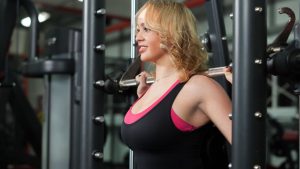Barbell Squats: Building Strength and Stability
1. Back Squat
The back squat is a quintessential barbell exercise. Beginners can start with just the barbell to get comfortable with the movement. This exercise primarily targets the quadriceps, hamstrings, glutes, and lower back muscles. Proper form is crucial to prevent injury, so focus on maintaining a straight back and keeping the knees aligned with the toes while lowering into the squat.

2. Front Squat
The front squat places more emphasis on the quadriceps and core muscles. With the barbell positioned across the front of the shoulders, this variation challenges balance and stability. For beginners, it’s advisable to begin with lighter weights to master the technique before gradually increasing the load.
3. Overhead Squat
While more challenging, the overhead squat engages the entire body, promoting balance, flexibility, and core strength. Beginners can start with a light barbell or even a PVC pipe to perfect their form before progressing to heavier weights.
Dumbbell Squats: Versatility and Control
4. Goblet Squat
The goblet squat is an excellent introductory dumbbell exercise for beginners. Holding a dumbbell close to the chest, lower into a squat position while keeping the back straight and the chest up. This exercise effectively targets the quadriceps, glutes, and core muscles while allowing for better control and balance.
5. Split Squat
Using dumbbells for split squats helps improve balance and stability. By stepping one foot backward onto a bench or elevated surface and lowering into a lunge-like position, beginners can effectively work the quadriceps, hamstrings, and glutes while reducing the load on the lower back.

6. Sumo Squat
The sumo squat with dumbbells targets the inner thighs, glutes, and quadriceps. It involves a wide stance and holding a dumbbell with both hands between the legs while squatting down. Beginners can adjust the weight to ensure proper form and gradually increase it as they become more comfortable.
So.
For beginners, both barbell and dumbbell squats offer unique benefits. Barbell squats focus on building overall strength and stability, while dumbbell squats provide versatility and better control, making them ideal for honing technique and form. Starting with lighter weights and mastering proper form is crucial before progressing to heavier loads to prevent injury and maximize results.
Remember, the choice between barbells and dumbbells ultimately depends on personal preferences, fitness goals, and comfort levels. Incorporating a variety of squat exercises into a routine can offer a well-rounded lower body workout, aiding in muscle development, strength gain, and overall fitness improvement.
Let’s delve further into the considerations for beginners when choosing between barbell and dumbbell squats.
Factors to Consider for Beginners
Equipment Accessibility and Comfort
Barbell squats typically require access to a squat rack, which might not always be available for beginners working out at home. Dumbbell squats, on the other hand, can be performed with minimal equipment, making them more accessible for home workouts. Additionally, some beginners might find holding and maneuvering dumbbells more comfortable than a barbell, especially when focusing on mastering form.
Learning Curve and Technique
Mastering proper form is crucial in squat exercises to prevent injury and maximize effectiveness. While barbell squats demand more technical proficiency due to balance and weight distribution, dumbbell squats often have a lower learning curve, allowing beginners to focus on form without the added complexity of managing a barbell.
Versatility and Progression
Dumbbell squats offer greater versatility in terms of variations and progression. Beginners can easily adjust weights, try different squat variations, and gradually increase resistance as they progress. This flexibility can be advantageous for those looking to target specific muscle groups or gradually intensify their workouts.
Stabilization and Muscle Engagement
Barbell squats require greater stabilization due to the weight being distributed across the upper back or front shoulders. This engagement of stabilizing muscles can contribute to overall strength gains and improved balance. However, dumbbell squats also challenge stability and engage core muscles while providing more control over each movement.
Personal Preference and Goals
Ultimately, the choice between barbell and dumbbell squats depends on individual preferences, fitness goals, and comfort levels. Some beginners might prefer the feeling of a barbell across their back, while others might find it more comfortable to hold dumbbells at their sides or in a goblet position. Aligning the choice with specific fitness goals, such as muscle hypertrophy, strength gain, or functional fitness, can also guide selection.
Final Thoughts
Both barbell and dumbbell squats offer significant benefits for beginners embarking on their fitness journey. Beginners should focus on mastering proper technique, gradually increasing weights, and listening to their bodies to prevent injury. Incorporating a mix of both barbell and dumbbell squats into a workout routine can provide a well-rounded lower body workout while allowing for variation and progression.
Remember, consistency and proper form are key to reaping the maximum benefits from squat exercises. Whether choosing barbells or dumbbells, always prioritize safety, listen to your body, and seek guidance from fitness professionals when needed.
As you progress in your fitness journey, experimenting with various squat variations and equipment can help you discover what works best for you and brings you closer to your fitness goals.
External links for further reading:
Squat Variations for Beginner Strength Training
The Benefits of Barbell Squats vs. Dumbbell Squats
How to Choose the Right Squat for Your Goals
How to Do Barbell Squats Correctly
Comparison tabular
| Aspect | Barbell Squats | Dumbbell Squats |
|---|---|---|
| Equipment Required | Squat rack, barbell, weights | Dumbbells |
| Accessibility | May require gym or specialized equipment | Can be performed at home or in the gym |
| Learning Curve | Higher due to balancing and form | Lower, allowing focus on form |
| Versatility | Limited variations without additional equipment | Various variations and easy progression |
| Stabilization | Engages stabilizing muscles extensively | Challenges stability with more control |
| Muscle Engagement | Targets multiple muscle groups | Engages core, adaptable to specific focus |
| Comfort | Some may find it less comfortable to hold | Often perceived as more comfortable |
| Progression | Gradual weight increments | Easy weight adjustment and variation |
| Personal Preference | Preference for feeling of the barbell | May prefer holding and maneuvering dumbbells |
This table summarizes the fundamental aspects to consider when choosing between barbell and dumbbell squats as a beginner. Remember, individual preferences, fitness goals, and accessibility should guide your choice to optimize your workout routine.
Wrapping up
When it comes to choosing between barbell and dumbbell squats as a beginner, there’s no one-size-fits-all answer. Both offer unique advantages, and your choice should align with your comfort level, accessibility to equipment, and fitness goals.
Barbell squats demand a higher learning curve but engage various muscle groups extensively, while dumbbell squats provide versatility and easier progression. Mastering proper form and gradually increasing weights are key regardless of the equipment you choose.
Experimentation and consistency are your allies. Mix and match these exercises, listen to your body, and seek guidance when needed. Whether it’s the feeling of a barbell across your back or the control of holding dumbbells, your preference matters in staying committed to your fitness journey.
Ultimately, it’s about finding what works best for you. Stay safe, focus on form, and enjoy the journey toward a stronger, healthier you!
If you’re ready to dive deeper into these exercises, check out our recommended external resources in the previous sections. Happy squatting.

Hey there, it’s Mike Rrsq, the Editor-in-Chief over at Jsquat.com, and I’m absolutely obsessed with all things squat fitness! I’ve been lucky enough to get some serious recognition for my work in this field. With a solid background in the fitness and wellness industry, I’ve been there right from the get-go, helping shape this website into what it is today.
You see, I’m not just the boss around here; I’m also a passionate contributor. I love sharing my insights through my articles, and trust me, they’re not your run-of-the-mill stuff. Each piece I write is a labor of love, filled with my expertise and real-world experience in the fitness universe. So, if you’re into fitness and looking for some inspiration, you’re in the right place!
Related Posts
- Best 3 most effective squat variations you need for targeting the adductor magnus.
Squat is one of the most effective exercises that you can do to target quads…
- The Best 3 Most Effective Squat variations for targeting the obliques.
Squats are renowned for their ability to strengthen and tone the lower body, but did…
- The Top 3 Effective Squat Variations you need for better swimming performance.
Swimming is an intricate sport that demands a blend of strength, endurance, and technique. While…
- The best 5 most effective squat variations you need for better basketball performance
Basketball demands a unique blend of strength, agility, and explosive power. Choosing the right squat…
- The 3 squat variations beginners Should do with a personal trainer's guidance.
When venturing into the world of strength training, mastering proper squat techniques stands as a…
- The best 3 most effective squat variations you need for better soccer performance.
Squats are a foundational exercise for athletes across various sports, and for soccer players, they…
- The top 3 effective squat Variations 19-year-old males need to build explosive strength
Squats are foundational exercises for enhancing lower body strength and power. For a 19-year-old male…
- The Top 3 Effective Squat Variations you need for better volleyball performance
Volleyball demands agility, power, and endurance. As an athlete, fine-tuning your performance can be the…
